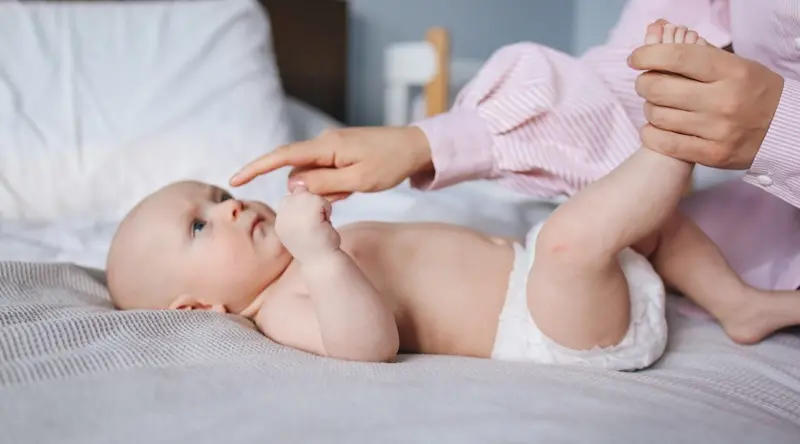settings
children
With Famly since
When you’re a baby, your days are measured in diapers.
It wouldn’t be unusual to burn through half a dozen diapers a day. In your first three years of life, you can expect to go through about 5,000 fresh ones. That mountain of diapers represents hundreds of hours spent on the changing table.
And those hours on the changing table tell you what the world is like.
The fact is, diapering is much more than a question of health and hygiene. Amy Hunter, an Assistant Professor and children’s mental health specialist from Georgetown University’s Center for Child and Human Development, tells me that diaper changes can be one of the most influential developmental routines in early childhood.
“Diaper changes are part of how babies and toddlers learn about relationships, about themselves, and their bodies. They take those lessons throughout their whole lives. So if you take the time to make the diapering routine a tender, caring, gentle experience, then babies will start to learn that that’s what the world is like,” Amy says.
Now, not every diaper change has to be (or can be) a grand ceremony. But research suggests that if we can make our daily diaper changes just a bit more mindful, we can form stronger bonds with babies, and set them off with a more secure, supportive start in life.
So in this article, we’ll paint a picture of better diapering at your child care center. You’ll learn why good diapering matters, and all the little ways you can make each diaper change a more enriching experience for children.
Let’s get started.

A baby step toward better diapering
Of course, reading this article is one thing. But remembering everything in the middle of a busy day, when you’ve got three babies balanced in your lap, is another thing entirely.
So when it comes to better diapering, you can start small — and even that small start can make a big difference.
Carla Goble knows all about good diapering. She’s an early educator, a founding member of the Oklahoma Early Childhood Education Organization, and a published author on infant-toddler bonding and best diapering practices. She says if you’re going to do just one thing, start by simply saying what you’re doing out loud as you change a diaper.
As she explains, narrating the process out loud is a simple way to help you be more mindful of how the child experiences the diapering process, especially in the middle of a hectic day.
“Working in child care, you’ve got to figure out how to be efficient, and sometimes that efficiency takes over. But talking out loud can help you think about all the moments during diapering that are developmental and learning opportunities for children,” she says. “As a start, it’s enough just to be cognizant that what you’re doing is important, and it can have some really positive outcomes for young children.”
But why does changing a diaper have such a big impact on child development? Well, that’s due to the fact that we do it about 5,000 times.
Why children learn so much from a diaper change
Routines are a big part of child development: Repeating things over and over is what teaches children about themselves and the world.
And as far as routines go, a diaper change is one you’ll always be able to count on.
Like naptime routines, mealtimes or the daily schedule at your child care setting, the consistent repetition involved in diapering gives babies a framework to start building memories and noticing patterns in the world, and to help adjust their own rhythms to the structure of their environment.
And just like those other routines, diapering is also part of developmentally appropriate practice (DAP) — the scaffolding process by which we build our interactions with babies to keep supporting their independence and growth.
We’ll get into all these more down below, but your diapering routine is a learning experience for babies in three big ways:
- Diapering teaches babies about their bodies. We can help children explore and understand their own bodies, and to form foundational experiences of how other people respect and treat their bodies.
- Diapering models caring relationships. Do we use a soft voice, and a gentle touch when we change diapers? Are we hurried and distant, or engaged and warm? The physical intimacy of a diaper change shapes infants’ understanding of how caregivers connect with them and treat them.
- Diapering helps move children toward independence. Scaffolding our diapering practice can help children develop a strong sense of independence, especially as they graduate into the toileting process.
Again, as Amy Hunter explains, this doesn’t mean that every diaper change is a make-or-break moment to bond with your baby. What’s important is the big-picture pattern.
“Of course, it’s not every diaper change where you can take advantage of all that learning and relationship building. But if we’re doing this up to ten times a day, it’s a lot of natural one-on-one time that we can use,” she says.

The big ideas
Why we can’t let diapering be ‘gross’
If talking in-depth about diapering makes you feel a bit shy, don’t worry. You’re not alone.
But it’s worth remembering that diapering isn’t embarrassing or gross for babies. In fact, it’s one of the most regular things in their world. So even if you do feel a little grossed out, it’s important to not let that show — because babies will learn from your example.
“If you’re saying, ‘Oh, this is gross!’ every time you change a diaper, that’s what gets built into a baby’s understanding of their body, and how other people react to them. You can imagine if that happens over and over, it could produce some shame. Babies could learn that there’s something wrong with bodily functions, or that their body does something that disgusts others,” Amy Hunter says.
As Carla Goble points out, if we’re more focused on how a diaper change feels awkward or gross to us, we’re taking the baby’s needs and experience out of focus. So part of better diapering, she says, is doing some self-reflection on our own attitudes about bodies and body functions.
“The early impressions we learn during diapering can really affect our attitudes and confidence about our bodies later in life,” she says. “We’ve got to ask ourselves: What sort of attitude do I want this baby to develop and feel through our interactions? And how can I model that through the language and touch I use during diapering?”

Giving children more control in a diaper change
Diapering isn’t just about teaching children about the world — the experience can also help children with self-regulation, and building a sense of independence.
As you know, toddlers throw tantrums when they can’t handle a big emotion. And often enough, that stems from wanting to feel more in control. So especially with two- and three-year-olds, it’s good to look for ways they can help during diapering.
“Babies are competence-motivated. They come into the world wanting to learn how things work, and to do things for themselves,” Carla Goble says. “When we’re diapering toddlers, it’s good to start looking for ways to enable and involve them in their own diaper change.”
When it comes to diapering, you can use the routine to teach independence in two big ways:
- Ask children if they’re ready for a change first. “Just picking up a toddler without warning can be disorienting for them, and can set off a power struggle during the diaper change,” Carla says. “Asking if they’re ready teaches children to set boundaries, and teaches them that they can expect others to respect their body and those boundaries.”
- Invite toddlers to help out during the process. “Especially when children start to move toward independent toileting, it’s good to look at what children can help with, or what they can do themselves,” Amy says. “Can they hold the fresh diaper, or grab a wet wipe from the pack? Can they slip on the fresh diaper themselves? It’s about looking at diapering as a part of the scaffolding process.”

The dos and don’ts of better diapering
So what exactly does good diapering look like in practice? We’ve got your do’s and don’ts of diapering right here, to help you understand how these ideas meet the floor at your child care setting.
Do
- Narrate what you’re doing. Talking through the diapering process out loud gives children predictability — things don’t just happen to them, but they can expect and understand what’s happening. It’s also a big way to build language skills together.
- Include your baby in the process. Diapering should be something you do together. Use a soft touch to tickle their feet, explain the steps of changing a diaper, or talk about whatever interests your baby in the room.
- Use gentle hands, not busy ones. Rushing through the whole process tells the baby you’re mostly interested in getting it over with, which can send the message that they’ve done something wrong or gross.
- Slow down your diapering. Planning for a few more minutes in your diapering routine gives you the space to be gentler and more thoughtful in your words and actions during the process.
Don’t
- Don’t let it show if you’re a bit grossed out. Saying “Ew, smells like someone needs a change!” Tells children they’ve done something gross, which can plant an unhealthy understanding of their own body and bodily functions. Responding to smells and private parts with a respectful tone helps children understand diaper changes as normal and healthy.
- Don’t be afraid to postpone a few minutes. If a child is deeply engaged in play, abruptly yanking them out for a fresh diaper is going to make that change harder for everyone. In terms of health and hygiene, waiting a few minutes won’t hurt as you help children find a good time for a fresh diaper.
- Don’t pick children up for a change without warning. Even with newborns, Carla and Amy recommend letting them know before you move them over to the changing table. It lays the foundation that we have our boundaries and control over ourselves, which becomes even more important in diaper changes with two- and three-year-olds.
Try learning journals for free
Add observations, and build digital learning journals to share with families instantly. All with your completely free 14-day trial.
Get started









